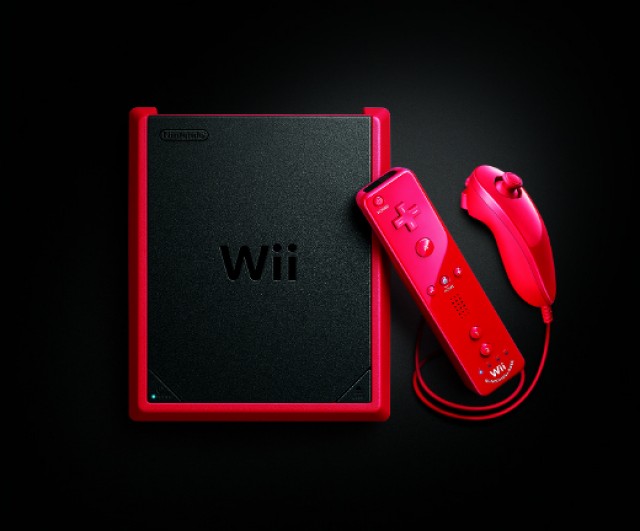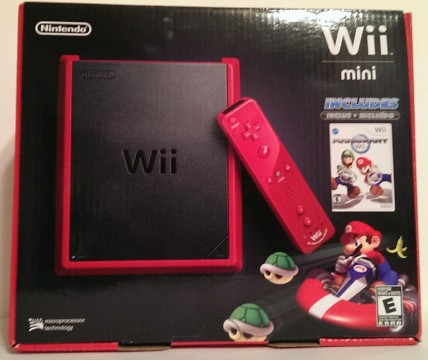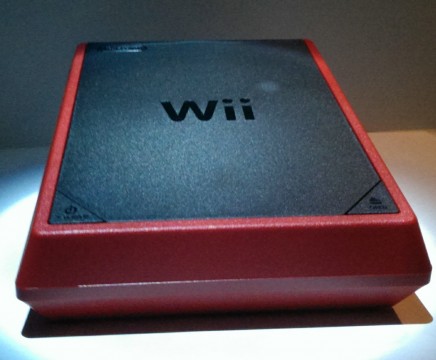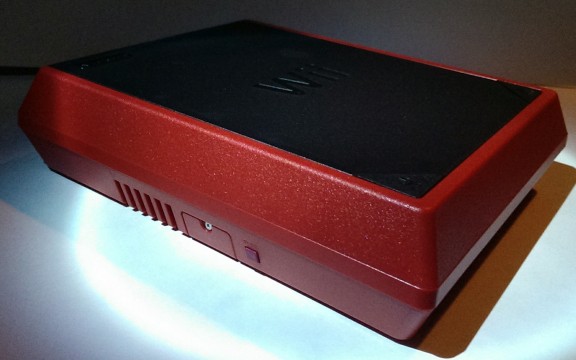
When Nintendo announced that the Wii Mini, a smaller, cheaper model of its popular Wii system, was coming to US retailers this November, I gave a little whoop of joy. It was disappointing last year to hear that the redesigned system would be heading to our Canadian brethren and not us, so I was happy that American fans would finally be able to get the shot to purchase one. For the first time since SNES was shrunk to the SNS-101 model (or SNES 2, among other names), Nintendo has graced fans with a budget version of one of its home consoles. Read on to learn about Wii Mini and whether it’s the right system for you.

Slipping Wii Mini out of its box, I found that the unit is notably smaller and lighter than the original Wii model. The bulk of the box’s weight comes from the included chords, sensor bar, a copy of Mario Kart Wii, and a highly sought after red Wii Remote Plus and matching Nunchuk. Wii Mini itself is very reminiscent of NES, with beveled edges and vertical notches on its undersides. The housing is comprised of a similar plastic to that of 2DS; matte and textured, as opposed to shiny and glossy. The automated disc slot has been swapped with a manual top-loading tray, which, combined with all the other changes, makes the Mini markedly distinct from the original Wii design. Even the colors break from the iconic white finish and blue light of the initial launch system, with Nintendo instead opting for a combo of red and black. This is a smart move, as by so boldly differentiating Wii Mini from the look of the original Wii, Nintendo has positioned the remodeled system to be less visually confusing to customers. After all, Wii U itself has been criticized for not being all that removed from the original Wii’s appearance, so there’s no sense for Nintendo to further consumer confusion with a third, similar console. It’s tough to judge between Wii and Wii Mini’s designs, as both are inherently sleek and dynamic, but in different ways. Wii Mini is perhaps less elegant, but has a certain allure all its own that I find irresistible. If nothing else, it certainly doesn’t look like any other console on the market, right now.

With Wii Mini’s physical differences out of the way, let’s turn to the internal ones. Wii Mini maintains the omission of GameCube functionality that has been in place since the 2011 debut of the Family Edition Wii. While that’s perhaps not as important to most incoming customers, what will give some people pause is the lack of any form of online capabilities for Wii Mini. No WiiWare, no Virtual Console, no online multiplayer, and not even a whiff of an SD card slot. The loss of WiiWare and Virtual Console are perhaps the heaviest blows to take, as both services increase Wii’s library of games by a fair margin. I think, though, that focusing on the removal of online is missing the point of Wii Mini. Wii was never a heavyweight in the online multiplayer arena, outside of Mario Kart Wii and the Call of Duty titles (there were quite a few people playing them, believe it or not), and though there are those who indulged in downloadable titles for Wii, the number is small compared to that of those who didn’t. Wii Mini is intended to tap into a specific demographic of player, rather than try to please everyone.
Nintendo’s move with Wii Mini brings to mind Microsoft’s Xbox 360 Arcade model that came without a hard drive. Despite 360’s stance as the online leader, Microsoft saw the value of getting people playing, whether the experience was complete or not. As a point of entry, Arcade units were invaluable to Microsoft’s efforts to reach players not yet on board with online and downloading games. Even if they never became converts outside of the free downloadable titles offered with the system, they’d still be buying disc-based Xbox 360 games. Wii Mini puts Nintendo in a similar position. At worst, Nintendo sells a few more copies of Wii Sports and New Super Mario Bros. Wii; at best, these people’s appetites are whetted for Wii U. Targeting different types of consumers is something that Apple, for example, has done to great success, offering different variations of its hardware in order to satisfy particular customer needs and maximize saturation. Admittedly, Wii Mini might have been better timed if released a couple of years ago, but with it and 2DS, Nintendo is making a move that will hopefully diversify and enrich its user base.

So, should you go out and buy a Wii Mini? For collectors, it’s a done deal, but for more practical players, I’d say only invest in the unit if your Wii is on the fritz and you’re not yet ready to pick up a Wii U. The Wii Mini plays all of Wii’s back catalog, and its pleasing form factor makes it easy to love. I also think this redesign is wonderful for younger players, as its more durable exterior and simple top-loading lid make it the perfect introductory system for kids who might have been rough on an original Wii. With system prices ratcheted up to $400 and $500, Wii Mini strives to include those who might be struggling for cash, too, a sector of the gaming population who are all too often overlooked. Video games are inching closer to being more inclusive, and Wii Mini is a small part of how to achieve that goal. Definitely keep this system in mind as the holiday shopping season ramps up!




 ShareThis
ShareThis







I must say, it may be a shell of a Wii in terms of functionality, but it would make a damn fine set piece for my collection.